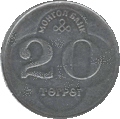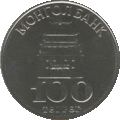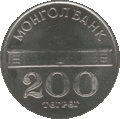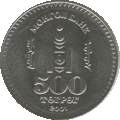Mongolian tögrög facts for kids
Quick facts for kids Mongolian tögrög |
|||||
|---|---|---|---|---|---|
|
|||||
| ISO 4217 Code | MNT | ||||
| User(s) | |||||
| Inflation | 7.9% | ||||
| Source | Bank of Mongolia homepage, December 2023. | ||||
| Subunit | |||||
| 1⁄100 | möngö (мөнгө/ᠮᠥᠩᠭᠦ) | ||||
| Symbol | ₮ | ||||
| Plural | The language(s) of this currency does not have a morphological plural distinction. | ||||
| Coins | ₮20, ₮50, ₮100, ₮200, ₮500 | ||||
| Banknotes | |||||
| Freq. used | ₮10, ₮20, ₮50, ₮100, ₮500, ₮1,000, ₮5,000, ₮10,000, ₮20,000 | ||||
| Rarely used | ₮1, ₮5 | ||||
The tögrög (pronounced "too-gruhg") is the official money of Mongolia. You might also see it spelled as tugrik. Its special symbol is ₮.
Long ago, one tögrög was divided into 100 smaller units called möngö. Today, möngö coins are not used for everyday shopping because they are worth very little. The smallest paper money you'll commonly see is the 10-tögrög note. The largest is the 20,000-tögrög note.
In 2010, the tögrög became stronger compared to the US dollar. This happened because Mongolia's mining industry was growing a lot. However, from 2013 to 2014, its value dropped. This was due to less money being invested from other countries and lower earnings from mining.
Contents
What Does "Tögrög" Mean?
The word tögrög (төгрөг) means "circle" or "a round object." It's like how we might call a coin a "round." Today, this word is mostly used when talking about money. One special phrase where it's still used is tögrög sar, which means 'full moon'.
A Brief History of Mongolian Money
The tögrög was first introduced on December 9, 1925. At that time, its value was the same as one Soviet ruble. One tögrög or ruble was worth about 18 grams of silver.
The tögrög replaced older money like the Mongolian dollar. By April 1, 1928, it became the only legal money in Mongolia.
Möngö coins are no longer used for buying things. They are now mostly sold online or to tourists as cool collector's items.
Mongolian Coins Through Time
During the time when Mongolia was a socialist country, there were many different coins. These included 1, 2, 5, 10, 15, 20, and 50 möngö, plus 1 tögrög coins.
After 1992, when the Mongolian People's Republic ended, prices started to rise quickly. Because of this, möngö coins were stopped. New coins with higher tögrög values were made instead.
Today, the coins you might see are ₮20, ₮50, ₮100, ₮200, and ₮500. These coins were first made in 1994, except for the 500 tögrög coin, which came out in 2001. The 20 and 50 tögrög coins are made of aluminum. The 100, 200, and 500 tögrög coins are made of cupronickel, which is a mix of copper and nickel.
The front side of the 100 and 200 tögrög coins shows the value and famous buildings. The 100 tögrög coin features the Janraisig Temple, and the 200 tögrög coin shows the Government House. The back of these coins, and all other current coins, features the Soyombo symbol. This is an important national symbol of Mongolia.
Mongolian Paper Money (Banknotes)
In the past, Mongolian banknotes looked a lot like the Soviet ruble. They had similar colors and designs. The values were 1, 3, 5, 10, 25, 50, and 100 tögrög.
Here are some of the colors for those old banknotes:
- 1 tögrög: brown
- 3 tögrög: green
- 5 tögrög: blue
- 10 tögrög: red
- 20 tögrög: green
- 25 tögrög: lilac
- 50 tögrög: green
- 100 tögrög: brown
All the old banknotes used to be printed in the Soviet Union. Now, most modern tögrög banknotes are printed in the United Kingdom.
Current Banknotes (1993 Series)
Mongolia's current banknotes started being printed in 1993. They come in many different values and colors.
The smaller value notes (10, 20, 50, and 100 tögrög) usually feature Damdin Sükhbaatar. He was an important leader in Mongolia's history. These notes also show the Soyombo symbol and a Paiza, which was a special tablet used by Mongolian officials. The back of these notes often shows a beautiful mountainous landscape with horses. The 10 tögrög note is the smallest one you'll commonly use.
The higher value notes (500, 1,000, 5,000, 10,000, and 20,000 tögrög) feature Genghis Khan. He was a famous founder of the Mongol Empire. These notes also include the Soyombo symbol and a Paiza. The back of these notes shows different scenes. For example, the 500 and 1,000 tögrög notes show Mongolian yurts (traditional tents). The 5,000 and 10,000 tögrög notes show a "Drinking Fountain" from Genghis Khan's court. The 20,000 tögrög note shows the Nine White Banner.
Newer versions of these banknotes have special features to prevent fake money. For example, some higher value notes have a patch on the front that changes color. The very highest values, like the 10,000 and 20,000 tögrög notes, have a hologram of the Soyombo symbol.
| Current MNT exchange rates | |
|---|---|
| From Google Finance: | AUD CAD CHF EUR GBP HKD JPY USD KRW JPY USD |
| From Yahoo! Finance: | AUD CAD CHF EUR GBP HKD JPY USD KRW JPY USD |
| From XE.com: | AUD CAD CHF EUR GBP HKD JPY USD KRW JPY USD |
| From OANDA: | AUD CAD CHF EUR GBP HKD JPY USD KRW JPY USD |
| From fxtop.com: | AUD CAD CHF EUR GBP HKD JPY USD KRW JPY USD |
Images for kids
-
Socialist era tögrög in the National Museum of Mongolia
See also
- Economy of Mongolia





































